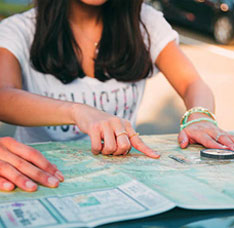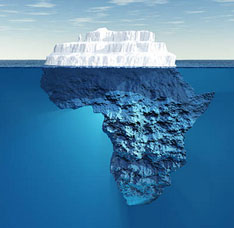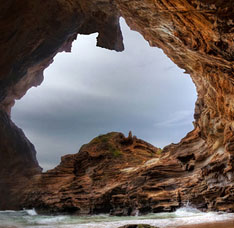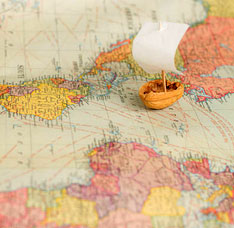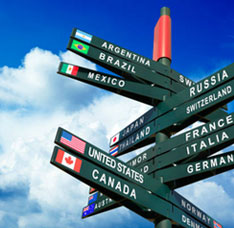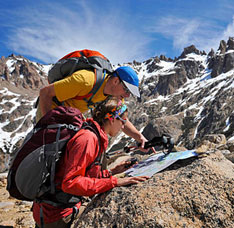Tour over 7 Continents of the World & the 5 Oceans
Our planet Earth, where all of us live is one of the most diverse planets known to human being. Though there have been so much advances in the astronomy over the years, we have never been able to find a planet as diverse as earth which is home to millions of living organisms like our mother earth is. In the millions and zillions of stars and planets which comprise our universe, our earth is of the size less than the size of the point of a needle. But for us, the small living beings on this planet, this is a very huge home.
Our earth is made up of large land masses known as continents and water bodies known as oceans. The earth has not been like this always as how we see it now. Millions of years before there were only one large land mass and a large ocean surrounding it. Later on the land mass started to split and drift apart surrounded by ocean on all sides. This process is still going on. Now we have 7 continents and 5 oceans which are home to all of us and millions of other living organisms. Let us learn about each of these seven continents and five oceans that make up our planet earth.
Tour over
7 Continents of the World & the 5 Oceans
Our planet Earth, where all of us live is one of the most diverse planets known to human being. Though there have been so much advances in the astronomy over the years, we have never been able to find a planet as diverse as earth which is home to millions of living organisms like our mother earth is. In the millions and zillions of stars and planets which comprise our universe, our earth is of the size less than the size of the point of a needle. But for us, the small living beings on this planet, this is a very huge home.
Our earth is made up of large land masses known as continents and water bodies known as oceans. The earth has not been like this always as how we see it now. Millions of years before there were only one large land mass and a large ocean surrounding it. Later on the land mass started to split and drift apart surrounded by ocean on all sides. This process is still going on. Now we have 7 continents and 5 oceans which are home to all of us and millions of other living organisms. Let us learn about each of these seven continents and five oceans that make up our planet earth.
Continents are the large land masses that we see on our earth. These hard land masses where people and other living organisms walk or crawl and make home are large in size, and are made up of many countries. There are also many small land masses which we call as islands, but continents are very large in size compared to these islands. There are 7 continents on earth. Many people combine the two continents Asia and Europe into a single continent and call it Eurasia. Many others combine the two continents North America and South America into one and call it the American continent. But in general there are seven large land masses on earth, namely Africa, antarctica, Asia, Australia, Europe, North America and South America. You must be wondering to know what are the 7 Continents of the World. You can get all the 7 continents of the world maps as well. Details are as follows!
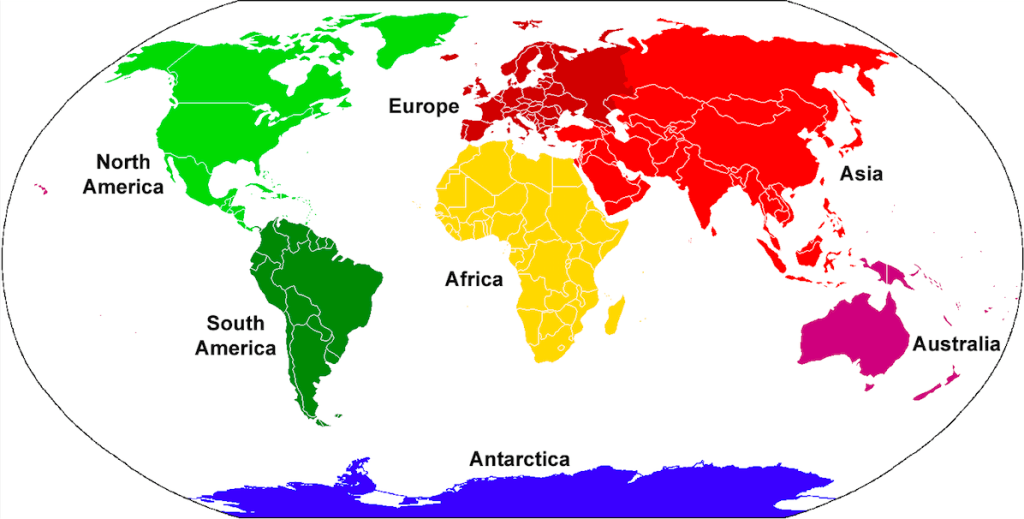
Before we get into talking in detail about the 7 Continents of the World, you should know a bit of its area and other needful details first. For that we have created a table which would get you all the required details on the go. Kindly follow the table given below and know more about our Continents.
| Continent | Area (km²) | Population | Populous City |
|---|---|---|---|
| Asia | 43,820,000 | 4,164,252,000 | Shanghai, China |
| Africa | 30,370,000 | 1,022,234,000 | Lagos, Nigeria |
| antarctica | 13,720,000 | 4,490 | McMurdo Station, US |
| Australia | 3,478,200 | 29,127,000 | Sydney, Australia |
| Europe | 3,930,000 | 738,199,000 | Moscow, Russia |
| North America | 9,460,000 | 542,056,000 | Mexico City, Mexico |
| South America | 6,890,000 | 392,555,000 | São Paulo, Brazil |
Africa

Africa is the second largest continent inthe world. It is also the second largest continent in the world interms of population. Africa is commonly referred to as the blackcontinent by many. This large land mass comprises of 54 countries and ishome to one billion people. About 15 percent of the world populationlives in this continent, which constitutes about 20 percent of the totalland area. Africa lies in the centre of the earth with the equatorpassing through its centre. It is the only continent that stretches fromthe northern temperate to the southern temperate zones. The climate ofAfrica is largely tropical in nature. The northern and southern parts ofAfrica have temperate climatic conditions. Africa is also considered tobe the birth place of mankind. The oldest fossils of Homo sapiens foundtill now have been from the eastern parts of this continent. This largeand diverse continent is home to lot of endangered species.
Africa is surrounded by the MediterraneanSea in the north, the Indian Ocean to the south east, the Suez Canaland the Red Sea to the northeast all along the Sinai Peninsula, and theAtlantic Ocean on the west. Madagascar and a large number ofarchipelagos are part of the continent. The population of Africa is theyoungest in the whole world. About 50% of the residents in the continentare younger than 19 years of age.
antarctica

antarctica is the southernmost continentof all. The geographic south pole of the earth is contained in thiscontinent. It is made of large permanent glaciers that surround theSouth Pole. This is one of the most uninhabitable places on earth. With avery small population of less than 5000 residents, antarctica is theleast populated continent on earth. It is also home to very few plantand animal species. antarctica is also the coldest landmass on earth andmuch of this continent is made of permanent glaciers. Around 98% of thecontinent is covered by ice of about 1.9 kilometres thick.
antarctica is the fifth largest among theseven continents. It is actually double the size of the whole ofAustralia. It is known to be the driest, coldest, and also the windiestcontinent. It has the highest elevation among all the continents, and isconsidered to be a complete desert. The temperature here is known tohave reached -89 degrees as well. Only cold adapted organisms have thecapacity to survive in this continent. Due to the hostile environmentand the lack of resources, this continent was largely neglected andisolated.
Asia

Asia is the largest continent on earthcovering about 9 percent of the earth's surface. It is also the mostpopulated continent on earth, home to an estimated population of around4.3 billion people. This large population makes it an important part ofthe world economy.
Asia is located mostly in the northernand eastern hemispheres of the earth. It covers around 30% of the totalland area, and is known to be home to the earliest human populations.Around 60% of the planet's human population were in this continent. Thiscontinent is known for the large size, dense settlements, and also thevast area of barely populated regions.
The boundaries of Asia are not veryclearly defined. There is actually no geographical separation as suchbetween Asia and Europe. The two continents form a large landmass whichis popularly called Eurasia. On the east of Asia you have the PacificOcean, Indian Ocean to the south and Arctic Ocean to the north. Thecontinent is known for its vast diversity in terms of culture,environments, ethnic groups, economics, historical background, and alsothe government systems.
Australia

The continent of Australia is a singlecountry continent. It is the sixth largest country by total area, and isalso the smallest of all the seven continents. Because of its size, andisolated location, it is also called as island continent. Covering anarea of 7617930 square kilometres, Australia lies in the Indo-Australian Plate. This continent is surrounded by Indian Ocean andPacific Ocean. Australia is one of the least populated continents and isrich in biodiversity. The Great Barrier Reef, which is the largestcoral reef in the world, is in Australia. It extends over 2000kilometres in the north east cost of Australia. Australia is also hometo world's largest monolith, Mount Augustus.
Officially known as the Commonwealth ofAustralia, the country is an Oceanian country. It comprises the whole ofAustralia, the island of Tasmania, and also a large number of othersmaller islands. The countries neighbouring Australia are East Timor,Indonesia, and Papua New Guinea to the north, Vanuatu and the SolomonIslands on the north-east, and New Zealand on the south-east.
Australia was mainly inhabited by theindigenous Australians for around 40,000 years before the British firstcame to settle here. They had over 250 language groups then. Today,Australia is one of the wealthiest countries in the world, and a welldeveloped one too. It is the 12thlargest economy in the world, and has the fifth-highest per capitaincome in the world. It is ranked among the highest in terms ofprovisions like quality of life, education, health, economic freedom,and also the protection of political rights and liberties.
Europe

Europe is the second smallest continentin the world. It comprises the westernmost peninsula of the giantEurasian landmass. Covering almost 2 percent of the earth's surfaceEurope takes 6.8 percent of the world's total land area. Europe is hometo almost 50 countries and is the third most populated continent in theworld after Asia and Africa. About 11 percent of the world's populationlives in Australia. Russia is the largest country in Europe and VaticanCity is the smallest. Russia has got territory in both the continents ofEurope and Asia, and it takes up around 40% of the land area of Europe.
Europe is divided from Asia by thewatershed divides of the Ural and Caucasus Mountains, the Ural River,the Caspian Sea, black sea and the waterways connecting black sea andAegean Sea. Europe is bordered by Arctic Ocean in the north side,Atlantic Ocean on the west side, Mediterranean Sea to the south andblack sea and connected water ways on the south east.
Europe, especially ancient Greece is known to be the birth place of the western culture. From the early 15thcentury, Europe has been playing a predominant role in the globalaffairs. It is also where the industrial revolution started. Thecountries of Europe had been controlled by the Americas, some parts ofAfrica, Oceania, and a large majority of the countries in Asia allthrough the times between the 16th and the 20thcenturies. Western Europe had been subject to a lot of radicalcultural, economic, and social changes due to the Industrial Revolutionthat began in Great Britain. By the year 1900, Europe contributed toabout 25% of the total world population.
The World Wars were both concentratedaround Europe, and that led to a decline in the dominance of thecontinent in world affairs by the time the world came on to the 20thcentury. Politics and economics had been affecting the countrieslargely leading to several changes all throughout history. Nowadays, theEuropean Union has started having an influence over the membercountries.
North America

North America is a continent which lieswholly in the northern hemisphere. It is bordered by Arctic Ocean in thenorth, Atlantic Ocean in the east, Pacific Ocean in the south and west,and South America and Caribbean Sea in the south east. North Americalies almost wholly in the western hemisphere. North America coversalmost 4.8 percent of the earth's surface and comprises around 16.5percent of the whole land area on earth. North America is home to nearly565 million people. About 7.5 percent of the world's population liveshere. It is the third largest continent in the world by area and fourthlargest continent by population. Most of the land and area of thecontinent is dominated by Canada, United States of America, Greenlandand Mexico. There are also many smaller states in the Central Americaand Caribbean regions.
South America

South America is a continent located inthe western hemisphere with most of its land area lying in the southernhemisphere and a relatively small portion in the northern hemisphere. Ithas Pacific Ocean to its western side, Atlantic Ocean in the north andeastern side, and North America and Caribbean Sea in the North Westside. With an area covering 17,840,000 square kilometres and apopulation of more than 3 billion, South America is the fourth largestcontinent in terms of size and fifth in terms of population. SouthAmerica is home to twelve sovereign states and two non sovereign states.It is generally considered to be a subcontinent of the Americas.
South America is a continent which isdiverse in terms of geography and biodiversity. The world's highestuninterrupted waterfall, angel falls is situated in Venezuela in SouthAmerica. The Amazon River, which is the largest river in the world interms of volume, is also in this continent. The Atacama Desert, which isthe driest non polar place on earth, and the Amazon forest which is thelargest rainforest on earth, is situated in this continent. It is alsohome to many interesting and unique species of animals such as anaconda,piranha, jaguar etc. The Amazon rainforests contains a major proportionof the earth's species. Brazil is the largest country in South Americaoccupying more than half of the continents land area and population.
Most of the population in this country isconcentrated near the eastern or western coasts. The far south regionsand the interior regions are just sparsely populated. The western partis dominated by the mighty Andes Mountains. The eastern part ahs gotboth highland regions and also lowlands. The major rivers flowingthrough the continent like Parana, Amazon, and Orinoco flow in thispart.
Through regular interactions of theindigenous people with the immigrants and conquerors from Europe, andthe slaves from Africa, the continent's cultural and ethnic outlook cameto be formed. After being colonised for long periods in history,Spanish and Portuguese came on to become the most spoken languages here.Western traditions are followed in several parts.
The Five Oceans
Up to now we were discussing only aboutthe land masses on earth which covers only 30 percent of the earth'ssurface. The larger portion of the earth's surface is covered by water.70 percent of the earth's surface is covered by water, out of which over96 percent is salt water in our oceans. These large water bodies whichsurround the continents are called oceans. Though they are allinterconnected, they are generally divided into 5 Oceans, namely, Pacific Ocean, Atlantic Ocean, Indian Ocean, Arctic Ocean and Antarctic Ocean. Know what are the 5 Oceans of the Planet earth and get more deeper into them.

Just like the available Continents, we should know more about all the big Oceans available on the Planet earth. Get all the 5 major Oceans along with all the details to describe what are the 5 Oceans of the Word and much more. Following table would let you know more about these giant Oceans.
| Rank | Ocean | Notes |
|---|---|---|
| 1 | Pacific | Separated into north and south pacific. |
| 2 | Atlantic | Separated into north and south Atlantic |
| 3 | Indian | Known as the sea south of India containing the water of Arabian and Laccadive Seas |
| 4 | Southern | Extension of the Pacific, Atlantic and Indian Oceans |
| 5 | Arctic | The sea around North pole containing the water of Greenland sea. |
Check out all the detailed reports about each of these 5 Oceans of the World. If you don't know about any, we have enlisted all the names of the 5 oceans so that you can get more about them easily.
Pacific Ocean

The largest of all the oceans is thePacific Ocean. It is located between the western coastlines of theAmerican continents and eastern coast lines of Asia and Africa. ArcticOcean lies to the north of Pacific Ocean and Antarctic Ocean in thesouth. Covering about 165,200,000 square kilometres the Pacific Oceanhas the longest total shore line of about 135,663 kilometres.
The Pacific Ocean covers 46% of the totalwater surface of the Earth, and covers more than a third of the totalsurface area. It is actually larger than all the land area combined. Thewater in the ocean represents around 50.1% of the total oceanic wateron earth. The ocean can be demarcated as the North Pacific Ocean and theSouth Pacific Ocean with the equator passing through the middle. Thedeepest point on the earth, the Mariana Trench, is in the North PacificOcean. The Pacific Ocean is known to be the most peaceful one.
Atlantic Ocean

Atlantic Ocean is the second largestocean in the world with an area of 106,400,000 square kilometres. It isbordered by Americas in the west and Africa and Europe in the east.Atlantic Ocean consists of the Mediterranean Sea, Caribbean Sea, BalticSea and the Gulf of Mexico. Like Pacific Ocean, Atlantic Ocean alsoreaches out to Arctic Ocean in the north and Antarctic Ocean in thesouth. Up to 15thcentury the Indian Ocean and eastern Atlantic Ocean were the only knownvoyaged seas in the world. It was the route for spice trade andcolonisation. The ocean is home to a lot of marine species, includingthe sperm whale which is the largest living toothed animal.
The equator divides the ocean in to theNorth Atlantic Ocean and the South Atlantic Ocean. The area north of theequator, between Africa and South America, is referred to as CentralAtlantic. The water in this part is very different from the waters inthe northern part, which is between Europe and North America.
The Atlantic Ocean is known to be thesaltiest. The processes of evaporation, precipitation, river inflow, andsea ice melting are the major contributors to the salinity. The waterin North Atlantic circulates in a clockwise direction, whereas the waterin the South Atlantic circulates in an anti-clockwise direction. Thisis due to the Coriolis Effect. This ocean is also the second youngestamong all oceans. Before 30 million years ago, it did not even exist.
Indian Ocean

Indian Ocean is the third largest oceanin the world. Covering an area of around 73,556,000 square kilometres,Indian Ocean has been home to a rich variety of human kind throughoutthe world history. Indian Ocean is bordered by eastern coast of Africa,the shores of Middle East and India in the north. It is separated fromthe Pacific Ocean by south East Asia and Australia. Indian Ocean is alsorich in exotic plan and animal species.
Around 20% of all the water on theEarth's surface is in the Indian Ocean. It is the youngest of all themajor oceans on the earth. It is a major sea route that connects Africa,the Middle East, and East Asia with the Americas and Europe. Around 40%of the world's offshore oil production is known to come from the IndianOcean. The different bordering countries largely exploit the beachsands that contain a rich amount of heavy minerals.
The India Ocean is known to be quitewarm, which keeps the production of phytoplanktons low. As such, thereis limited life in this ocean. The Mumbai port is the chief trading portin India on the coast of the Indian Ocean, and is known to be theGateway of India. The Port of Singapore is the busiest. There are a lotof other ports as well. The Indian Ocean encompasses a large number ofbays, gulfs, and straits as well.
Arctic Ocean

Arctic Ocean is the smallest andshallowest of all the oceans in the world. It clovers and area of around13,986,000 square kilometres. This is almost the size of the whole ofthe country of Russia. Arctic Ocean lies mostly in the Arctic Circle.Artic Ocean is surrounded by the Eurasian and north American continents.It includes the Hudson Bay, the North Sea and Barents Sea. For most ofthe time of the year, this sea is covered with ice often thick as up tohundreds of feet. Even during the summer season most of the oceanremains impassable.
Located in the Northern Hemisphere, theocean is generally considered to be the northernmost part of the totalWorld Ocean. The salinity and the surface temperature vary according tothe seasons because the ice cover freezes and melts periodically. On anaverage, it has the lowest salinity among all the oceans because of thelower amount of evaporation, flow of heavy freshwater from rivers andstreams, and also a limited connection to the other oceans around it.The main countries bordering the Arctic Ocean are Russia, Iceland,Norway, Canada, Greenland, and the United States. It includes a largenumber of bays, straits, and other tributary water bodies.
The deep sea North Polar Basin is dividedin to the two oceanic basins, the Amerasian Basin and the EurasianBasin, by the Lomonosov Ridge, and underwater ridge in the Arctic Ocean.The deepest point in the ocean is the Like Deep in the Eurasian Basin.
Relatively little plant life is found inthis ocean. Mainly Phytoplanktons are available. It houses a number ofendangered marine species as well.
Antarctic Ocean

Antarctic Ocean covering an area ofaround 20,327,000 square kilometres is the fourth largest ocean in theworld. It is also referred by many as the southern ocean as it islocated near to the South Pole. Antarctic Ocean has a great influence onthe earth's weather patterns. It joins the waters of Pacific Ocean,Atlantic Ocean and Indian Ocean with a persistent easterly current. Thecold, northward flowing waters in the Antarctic mix with the warmerwaters of the subantarctic in the ocean zone.
This ocean is considered to be theyoungest of all oceans, geologically. There are a wide variety of marineanimals that exist and rely on the phytoplankton in the AntarcticOcean. This area is rich for a number of marine species. The AntarcticOcean is a storehouse of natural resources. It contains giant oil andgas fields and valuable minerals as well.
Experience with us


